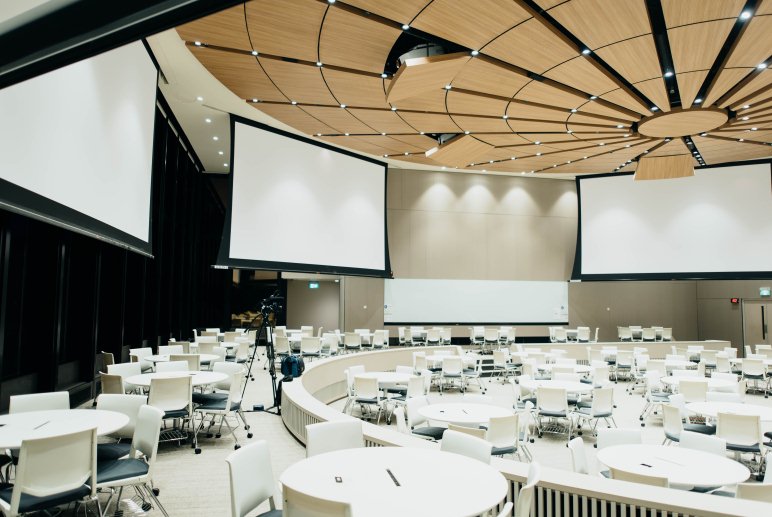
As an event organizer, you can leverage event technology and marketing channels to engage with attendees before, during, and after your event. It gives you the opportunity to:
- Share valuable, informative content with attendees.
- Start a conversation before the event begins and keep it going long after the event ends.
- Collect data throughout the event to monitor and analyze key event marketing metrics.
In this article, we’ll explore some of the different ways you can engage your attendees before, during, and after your event. By the time you’re done reading, you’ll be in a better position to put together a successful event engagement plan of your own.
Let’s get right to it.
Article Outline
Engaging Attendees Before the Event
#1: Send Email Invites
The first touch-point you’ll have with your attendees is through the email invites you send out. It’s essentially the first opportunity to make a positive impression on prospective attendees. You’ll also want to make sure you’re using this opportunity to generate some interest in your event and let them know what they can expect by attending. Make it clear to attendees the benefits they will receive from attending your event. Event Espresso’s MailChimp Integration lets you send email invites quickly to your entire list.
#2: Leverage Your Speakers
If you have a line-up of speakers scheduled to deliver a keynote presentation or give a talk, you can ask them to help you generate some buzz before the actual event. For instance, you might ask your speakers to write a guest blog post for your event website or participate in a live Twitter chat. Doing allows the speaker to engage with prospective attendees before the event and get an idea of what they’re hoping to learn from them. If you are promoting speakers or instructors or leaders in your industry, ask them to help promote you, too.
#3: Crowdsource Questions
If you have industry experts participating in a panel discussion during the event, you can let your event attendees know ahead of time so they are able to prepare the questions they’d like to ask. And if you’d like to kick things up a notch, you can even set up an event app that allows attendees to share the questions they’d like to ask each panel member. These apps often let attendees upvote the questions other attendees have asked. This makes it easier for the panel member to address the questions the entire audience is interested in.
#4: Publish Content
Using your event website to generate some buzz around your upcoming event is a great way to get the word out and get prospective attendees excited about the big day. The content you choose to publish can be a blog post, a short video, or a gallery of photos from a previous event – or a combination of all of the above.
#5: Use an Event Hashtag
If you’re looking to promote your event through social media platforms (like Twitter and Instagram), you’ll want to create an event hashtag before the event. There are many different ways you can benefit from creating an event hashtag:
- Provides you with the opportunity to engage with prospective attendees and reach a wider audience.
- Gives attendees a platform from where they can get quick event updates, learn more about your speaker line-up, and interact with other prospective attendees.
- Lets you monitor what prospective attendees are saying about your event and get a sentiment analysis.
Engaging Attendees During the Event

#6: Project a Social Wall
Event organizers set up social walls to personalize the event experience for attendees. And it’s all quite simple. You simply project a live stream of your event’s hashtag on large screens in your venue using a tool like Tagboard. This encourages attendees to share their experience on social media using your event hashtag and actively keeps them engaged.
#7: Respond to Live Tweets
Creating an event hashtag can help you improve your event’s experience for attendees during the event, as well. For instance, if an attendee is unhappy with something about the event, they’re likely to post about it on social media using the event hashtag. And if you’re monitoring live tweets, you’ll be in a better position to respond to them, take appropriate action, and make them feel valued.
#8: Create Networking Opportunities
One of the most important reasons why people attend events – especially corporate events like seminars, conferences, and product launches – is to network with peers. For this reason, it’s important that you make some room for networking sessions in your event’s itinerary. It’s a great opportunity for your own sales team to connect with the event attendees.
#9: Have a Mobile-Responsive Website
Having a mobile-responsive event website makes it easy for attendees to quickly get information about the event such as venue details, event calendar, itinerary, and the speaker line-up. You might also consider adding the speakers’ presentations to your event website so that attendees are able to download them to their mobile device (or laptop) and take notes during the keynote speeches. Event Espresso adapts to your WordPress theme to be as mobile friendly as the rest of your website.
#10: Live Stream Videos
During the event, you can live stream what’s going on behind-the-scenes to generate attendee engagement. For instance, you could use Facebook Live to live stream short interviews with your speakers.
Engaging Attendees After the Event

#11: Send Out Thank You Emails
Sending a simple thank you email to your attendees after the event has ended is a great way to show your appreciation and make them feel valued. You can make the email more engaging by including a link to video highlights or photos from the event.
#12: Follow Up With Leads
Depending on the type of event you’re organizing, your sales team might consider following up with leads, prospective customers, or existing customers a few days after the event. It’s important that these emails are personalized to each contact and follow up on the conversation they had with the attendees at the event.
#13: Ask for Feedback
Asking attendees to fill out a quick feedback survey after the event ends gives you an opportunity to continue engaging with them and learn more about their experience. For instance, you can ask them if the event met their objectives or if they had enough time to network with their peers. Doing so gives you a wealth of information that you can use to plan better events in the future.
#14: Create Your Own Content Hub
You can create a content hub of video (or audio) recordings of keynote speeches delivered at the event on your event website. It can serve as a resource for attendees who would like to share the presentations with their own teams. In addition to this, you can also use it to give your site’s visitors an inside look and encourage them to register for the next event.
#15: Build a Community
Giving your event’s speakers and attendees a platform to connect with each other after the event ends is a great way to increase engagement. You can create a Facebook Group, a Slack channel, an email newsletter or something similar. Attendees are able to ask speakers follow up questions related to their keynote, hold a discussion on their speech’s focus point, or share ideas with their peers.
#16: Recap Event Highlights
Writing a blog post recapping the event’s highlights allows you engage with those who were able to attend your event and those who couldn’t make it. Your blog post might include:
- Quick stats such as how many people were in attendance.
- Which industry issues were discussed by panel members.
- Photos or videos taken at the event.
- Downloadable resources such as presentation slides or keynote videos.
You could even consider sending the blog post out to your site’s subscribers through your weekly newsletter.
#17: Offer Special Discounts
Convincing past event attendees to attend another one of your events is much easier than building a new list of prospective attendees to market to. You can let them know when you’ll be hosting your next event and maybe even offer them a special discount.
Conclusion
Event management technology enables you to create individual experiences for attendees and make the event more personalized to them. We shared some of the ways you can engage with attendees before, during, and after the event along with some tools and resources to help you get started.
What are some of the ways you engage with your event attendees? Share your tips in the comments section below!
